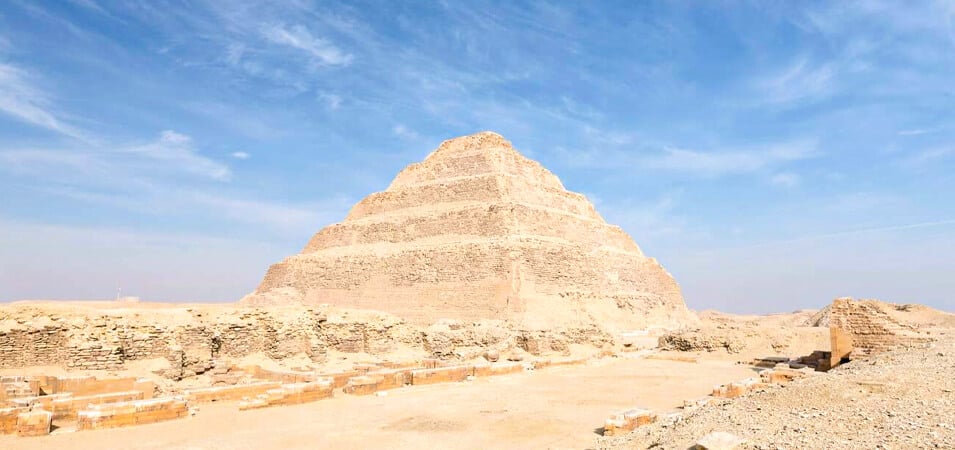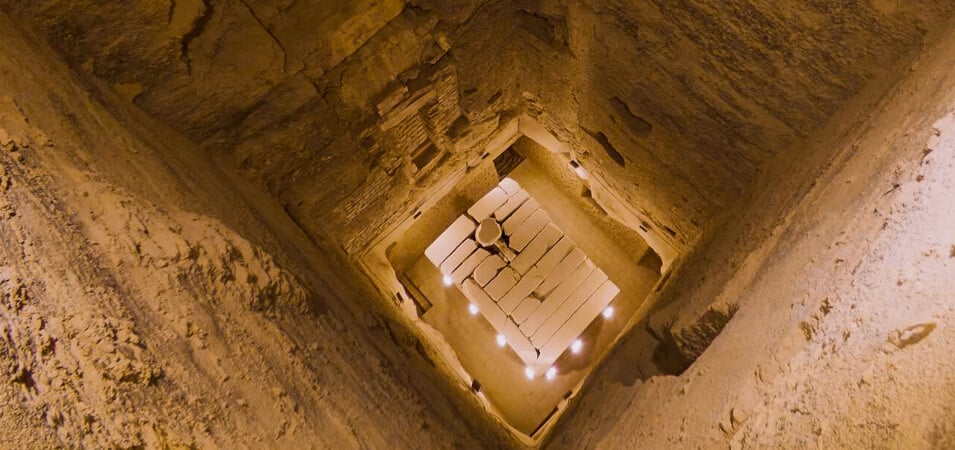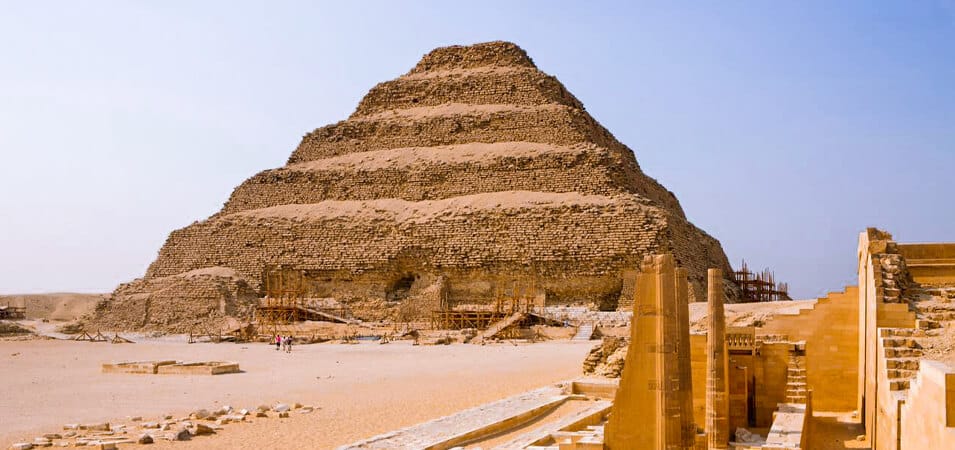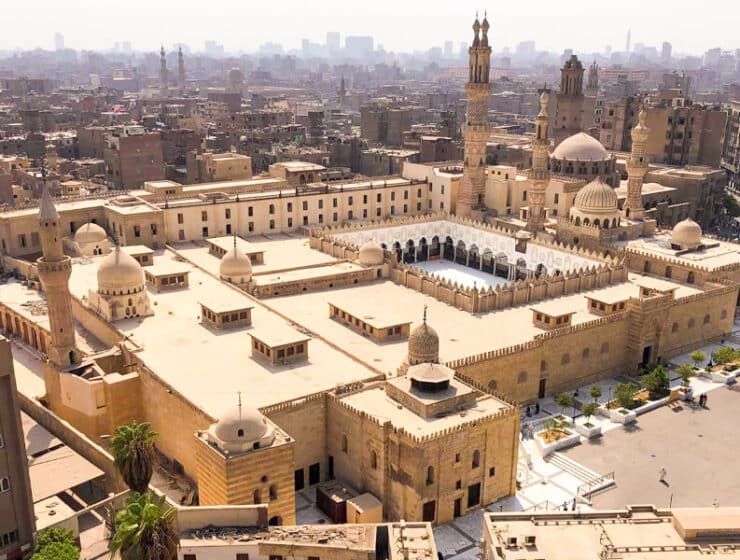The Pyramid of Djoser, also known as the Step Pyramid, is an iconic symbol of ancient Egypt’s architectural and historical prowess. Located in Saqqara, just south of Cairo, this remarkable structure dates back to the 27th century BCE, making it one of the world’s oldest stone monuments. This pyramid, which Pharaoh Djoser commissioned and the talented architect Imhotep created, represented a significant change in burial customs, moving from mastabas to a multi-tiered structure that would later inspire the creation of the famous pyramids at Giza. Djoser’s pyramid complex also includes a range of fascinating structures, such as temples, chapels, and tombs, offering invaluable insights into the religious and cultural life of the time. Join us on a journey through history as we explore the significance, construction, and mysteries surrounding the Pyramid of Djoser.
Explore the ancient Saqqara Necropolis of Cairo, home to the Step Pyramid.
Historical significance of the Pyramid of Djoser
The historical significance of the Pyramid of Djoser cannot be overstated. It represents a pivotal moment in ancient Egyptian history and architecture. Constructed during the Third Dynasty of the Old Kingdom, it served as the prototype for subsequent pyramids. Notably, the step-like design was a radical departure from earlier mastaba tombs, setting the stage for developing the smooth-sided pyramids at Giza. Beyond its architectural innovation, the Pyramid of Djoser also reflects Egypt’s growing centralization of power and resources, with Pharaoh Djoser consolidating authority to undertake such monumental construction projects. Furthermore, the surrounding pyramid complex sheds light on the time’s complex religious and funerary rituals. This historic landmark continues to captivate the imagination of people worldwide, making it an essential site for anyone interested in the ancient world and the evolution of human civilization.
Capture the moment with our Photography Tours in Cairo.
Construction and architectural features of the Pyramid of Djoser

The construction and architectural features of the Pyramid of Djoser are a testament to the ingenuity of ancient Egyptian builders and the visionary genius of its chief architect, Imhotep. This monumental structure, built over 4,600 years ago, comprises six massive stepped layers resembling a towering staircase. The pyramid’s core is made of local limestone, and its distinctive step-like design is encased in fine Tura limestone. Its innovative construction techniques set Djoser’s pyramid apart, including using a complex network of underground tunnels and chambers, most notably the burial chamber deep within the pyramid. The pyramid complex also comprises various temples and courtyards, further showcasing the architectural prowess of the time. As the world’s oldest colossal stone structure, the Pyramid of Djoser remains a symbol of ancient Egypt’s advanced engineering skills and its enduring legacy in architecture and monumental construction.
Visit the iconic Salah El-Din Citadel and its impressive medieval architecture.
Comparison with other pyramids in Egypt
When comparing the Pyramid of Djoser to other pyramids in Egypt, several notable distinctions and similarities emerge. Djoser’s pyramid in Saqqara stands out as the earliest known pyramid. It has a stepped design, unlike the more familiar smooth-sided pyramids of Giza, such as the Great Pyramid of Khufu. At the same time, Djoser’s pyramid served as a burial monument for Pharaoh Djoser; later, pyramids at Giza primarily functioned similarly, albeit on a grander scale. These later pyramids are renowned for their precise alignment and massive size, particularly the Great Pyramid.
One fundamental similarity between Djoser’s pyramid and others is the complexity surrounding each structure. Pyramids in Egypt typically included mortuary temples, causeways, and pyramid complexes that played significant roles in religious and funerary rituals. Additionally, they all share a focus on astronomical alignment, emphasizing the connection between the pharaoh’s journey to the afterlife and celestial events.
While the design and scale of the Pyramid of Djoser distinguish it from later pyramids, its historical importance cannot be overstated. It marked a pivotal moment in the evolution of pyramid construction, influencing subsequent pyramid designs and serving as a precursor to the iconic pyramids at Giza. Each pyramid in Egypt offers unique insights into the cultural and technological achievements of its era, making them all integral to understanding ancient Egypt’s rich history and legacy.
Shop ’til you drop in the bustling Shopping in Cairo.
Restoration efforts and preservation of the Pyramid of Djoser
The restoration efforts and preservation of the Pyramid of Djoser have been ongoing for decades to safeguard this ancient marvel for future generations. Over time, the structure deteriorated significantly due to natural elements and human activity. However, dedicated teams of archaeologists, conservationists, and engineers have worked tirelessly to address these challenges.
One of the most remarkable restoration initiatives was the Djoser’s Step Pyramid Restoration Project, launched in collaboration with international experts. This project aimed to stabilize the pyramid’s structure, repair damaged stones, and reinforce its foundations. Modern techniques, such as 3D scanning and advanced engineering, have been employed to assess the pyramid’s condition and ensure that restoration work is accurate and long-lasting.
Efforts have also focused on preserving the delicate decorative elements within the complex, such as the intricate reliefs and inscriptions found in the temples. These carvings provide invaluable insights into ancient Egyptian culture and beliefs.
Preservation efforts extend beyond the physical structure, with measures in place to limit visitor impact and maintain the surrounding archaeological site. Educational programs and visitor centers have been established to promote awareness and appreciation of the pyramid’s historical significance.
Through these ongoing endeavors, the Pyramid of Djoser is a testament to human dedication to preserving our shared cultural heritage and allowing future generations to connect with the distant past.
The complex surrounding the Pyramid of Djoser

The complex surrounding the Pyramid of Djoser is a sprawling archaeological site that offers a multifaceted glimpse into ancient Egypt’s religious and cultural life during the Third Dynasty. This complex consists of several vital elements, each with its significance:
- The Pyramid: At the center of the complex stands the Step Pyramid itself, a monumental funerary structure dedicated to Pharaoh Djoser. Its unique, tiered design sets it apart from later Egyptian pyramids and significantly departs from the earlier mastaba-style tombs.
- Mortuary Complex: Adjacent to the pyramid, there is a vast mortuary complex featuring a range of structures, including the Heb-Sed Court, where the sed festival, a royal jubilee, might have been celebrated. The South Tomb, designed for the burial of important officials, is also part of this complex.
- Courtyards and Temples: The complex includes several courtyards and temples, such as the Heb-Sed Court, which likely served as ceremonial spaces for religious rituals and offerings. These structures provide insights into the spiritual practices and beliefs of ancient Egypt.
- Funerary Enclosures: Surrounding the pyramid are extensive funerary enclosures with walls and false doors that symbolize the afterlife. These enclosures were where offerings and ceremonies were conducted to honor the deceased pharaoh.
- Chapels and Offering Tables: Numerous chapels and offering tables are scattered throughout the complex, indicating the importance of rituals and offerings in ensuring the pharaoh’s journey to the afterlife.
- Burial Chambers and Tunnels: Beneath the pyramid, a labyrinthine network of tunnels and chambers has been discovered. These chambers include the central burial chamber of Pharaoh Djoser, where his coffin was placed.
The entire complex surrounding the Pyramid of Djoser provides a rich tapestry of archaeological and historical information, shedding light on ancient Egypt’s religious, architectural, and cultural aspects during the Old Kingdom period. It is a remarkable testament to the sophistication and complexity of this ancient civilization’s funerary practices and beliefs.
Visiting the Pyramid of Djoser – What to expect
Visiting the Pyramid of Djoser is a remarkable journey back in time to explore the rich history and architectural marvels of ancient Egypt. Here’s what you can expect when visiting this iconic site:
- Historical Immersion: As you approach the Pyramid of Djoser, you’ll be struck by its imposing stepped design, setting it apart from other pyramids in Egypt. Your visit begins with a deep dive into the history of the Third Dynasty and the significance of Pharaoh Djoser’s reign.
- Architectural Wonders: The pyramid complex boasts intricate structures, including courtyards, temples, chapels, and false doors. These architectural features offer insights into ancient Egypt’s religious and cultural practices and provide a captivating backdrop for exploration and photography.
- Underground Tunnels: Venture into the underground tunnels beneath the pyramid to discover the intricate burial chambers and corridors. These tunnels reveal the pyramid’s engineering sophistication and are a testament to the ancient Egyptians’ mastery of construction.
- Educational Opportunities: Many sites within the complex feature informative plaques and signage, providing historical context and explanations. Guided tours are often available, offering more profound insights into the significance of the structures and their role in ancient Egyptian civilization.
- Mysteries and Legends: Your visit may also encompass discussions of the secrets and legends surrounding the Pyramid of Djoser, including its supposed connections to the famed architect Imhotep.
- Conservation Efforts: Be mindful of the site’s ongoing restoration and preservation efforts. Respect the rules and guidelines to protect this ancient treasure for future generations.
- Scenic Surroundings: The Saqqara plateau, where the Pyramid of Djoser is located, offers picturesque vistas of the surrounding desert landscape, adding to the overall experience.
- Visitor Centers: Before or after your visit, you can explore visitor centers nearby that provide additional historical information, artifacts, and exhibits related to the site.
Explore our Tours:
- Day Tour to Giza Pyramids and Memphis and Saqqara
- Day Tour to Giza Pyramids, Memphis, Dahshur and Saqqara
- Day Tour to Memphis and Saqqara and Dahshur
- Day Tour to Giza Pyramids and Egyptian Museum and Citadel
- Day Tour to Giza Pyramids and Egyptian Museum and Khan Al Khalili
- Day Tour to Giza Pyramids and Egyptian Museum Of Civilization
- Giza Pyramids Sound and Light Show
- Half Day Tour To Giza Pyramids and Sphinx
Interesting facts and mysteries surrounding the Pyramid of Djoser

The Pyramid of Djoser is not only a marvel of ancient architecture but also shrouded in intriguing facts and mysteries that continue to capture the imagination of historians and enthusiasts alike. Here are some fascinating details and enigmas:
- Imhotep’s Legacy: Imhotep, the chief architect of Djoser’s pyramid, is considered one of the earliest known geniuses in human history. He was an architect, high priest, physician, and sage, making him a legendary figure.
- Staircase to the Stars: The Step Pyramid’s tiered design is believed to symbolize a staircase to the heavens, signifying the pharaoh’s ascent to the afterlife and the connection between earth and sky.
- The First Stone Monument: The Pyramid of Djoser is the world’s oldest colossal stone structure, marking a significant shift from mudbrick construction to durable limestone.
- Hieroglyphic Insights: The walls of the complex are adorned with intricate hieroglyphic inscriptions and reliefs, offering valuable insights into the religious beliefs and daily life of ancient Egypt.
- Mysterious Burial Chambers: The subterranean labyrinth beneath the pyramid holds numerous burial chambers and corridors, some of which remain unexplored. These hidden spaces continue to pique the curiosity of archaeologists and Egyptologists.
- Imhotep’s Deification: Imhotep, the pyramid’s architect, was revered in later periods, becoming a god of healing and wisdom, emphasizing the lasting impact of his contributions.
- Alignment with Constellations: Some researchers suggest that the pyramid’s layout may align with certain constellations, underscoring the importance of astronomy in ancient Egyptian culture.
- Sed Festival Pavilion: The Heb-Sed Court within the complex is thought to be associated with the sed festival, a royal jubilee celebration, highlighting the pyramid’s role in dynastic ceremonies.
- Ongoing Restoration: The ongoing restoration efforts at the site have uncovered discoveries, including previously unknown tunnels and structures, adding layers of mystery to Djoser’s complex.
- Cultural Symbol: The Pyramid of Djoser has left an indelible mark on popular culture, appearing in books, films, and video games, contributing to its enduring mystique.
These intriguing facts and mysteries surrounding the Pyramid of Djoser underscore its significance as a historical treasure and an enigmatic symbol of ancient Egypt’s grandeur and complexity.
Visiting the Pyramid of Djoser: Tips and recommendations.
When planning a visit to the Pyramid of Djoser, it’s essential to prepare adequately to make the most of your experience. Here are some valuable tips and recommendations:
- Research and Guided Tours: Research to understand the historical and cultural context before your visit. Consider joining a guided tour led by knowledgeable Egyptologists who can provide in-depth insights into the site’s significance.
- Respect Local Guidelines: Be mindful of local regulations and guidelines. Follow all instructions provided by authorities and respect the preservation efforts in place to protect the site.
- Comfortable Attire: Wear comfortable clothing and sturdy, closed-toe shoes suitable for walking on uneven terrain. Sunscreen, a hat, and sunglasses are also advisable, as the desert sun can be intense.
- Hydration: Bring a refillable water bottle to stay hydrated, especially during hot weather. Some areas may have yet to have readily available drinking water.
- Camera and Photography: Capture the beauty of the Pyramid of Djoser, but be aware of any restrictions on photography within specific areas. Always ask for permission if photographing local people.
- Visiting Hours: Check the official visiting hours and plan your visit accordingly. Sunrise or late afternoon can be excellent times for photography and avoiding crowds.
- Entrance Fees: Ensure you have the necessary entrance tickets or permits in advance to avoid any delays.
- Guided Interpretation: Consider renting an audio guide or using a mobile app that provides historical information and context as you explore the site.
- Respectful Behavior: Show respect for the site’s historical and cultural significance by refraining from touching or climbing on the ancient structures. Stay on designated paths and follow any posted rules.
- Pack Essentials: Carry essentials like a map, a flashlight (if exploring tunnels), insect repellent (if visiting in the evening), and a small first-aid kit.
- Local Cuisine: Explore local cuisine by sampling Egyptian dishes at nearby restaurants or food vendors. Be adventurous and try traditional dishes like koshari or falafel.
- Souvenirs: Support local artisans by purchasing souvenirs and crafts from authorized vendors. Ensure you’re not buying artifacts illegally removed from archaeological sites.
- Travel Insurance: Consider travel insurance that covers unexpected events or cancellations, especially if your visit is part of a more extensive trip.
- Responsible Tourism: Be a responsible traveler by minimizing your environmental impact and leaving no trace. Dispose of trash in designated bins.
Visiting the Pyramid of Djoser is an opportunity to immerse yourself in the rich history of ancient Egypt. By following these tips and recommendations, you can have a safe, respectful, and memorable experience while exploring this iconic archaeological site.
Conclusion
In conclusion, the Pyramid of Djoser is a timeless testament to ancient Egypt’s ingenuity and cultural significance. Its stepped design, historical importance, and the mysteries surrounding it make it a captivating destination for history enthusiasts and travelers alike. From its innovative construction to its ongoing preservation efforts, Djoser’s pyramid continues to inspire wonder and curiosity, offering a unique window into the distant past of one of the world’s most iconic civilizations. Whether you’re drawn to its architectural marvels, the enigmatic stories it holds, or the cultural insights it offers, a visit to the Pyramid of Djoser promises a remarkable journey through time and an enduring appreciation for the legacy of ancient Egypt.





